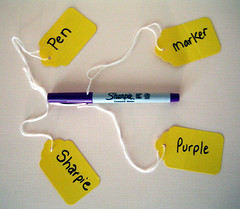This is the eighth in a series of blog posts I wrote for Darren Sidnick late last year. I am finally getting the rest of the series up. Part 1, part 2, part 3,, part 4, part 5, part 6, part 7 , part 8 , part 9 and part 1o are all here on the blog.
 We have talked throughout this series on communities of practice about “content.” Well, what the heck is content, why is it important and how do we make the most of it – especially when there is a LOT of it. First the what and why, then one idea about how to work with volume.
We have talked throughout this series on communities of practice about “content.” Well, what the heck is content, why is it important and how do we make the most of it – especially when there is a LOT of it. First the what and why, then one idea about how to work with volume.
What do we mean by “content?”
We can mean many things. Books, papers, self-paced learning modules, resources, learner discussions, reflective logs/blogs, images, audio, video. All the “stuff” that carries both the subject matter information and the artifacts of our interactions to make meaning of those subjects. Today we can capture both the resources and the interaction artifacts. We can draw from a closed, defined set of resources, or tap into the larger set of resources on the world wide web. The content may be dynamic, changing and evolving so one set of static resources that works for todays course is outdated in six months. So content is never fully “done.” It is alive in our learning communities.
Why is content important?
From a communities of practice perspective, it is important for two reasons. Content embodies or captures what we know about the domain (see Series 2: what-the-heck-is-a-domain-and-why-should-i-care?).
Second, the creation of content during the learning process is a key part of that very process. In CoP terms, this is “reification.” Here is a bit from the upcoming book by Etienne Wenger, John Smith and I that talks about reification.
“Members of a community of practice need to interact with each other as well as produce and share artifacts such as documents, tools, and links to resources. Sharing artifacts without interacting can inhibit the ability to negotiate the meaning of what is being shared. Interacting without producing artifacts can limit the extent and impact of learning. Indeed, the theory of communities of practice views learning together as involving the interplay of two fundamental processes of meaning making: Members engage directly in activities, interactions, conversations, reflections, and other forms of personal participation in the learning of the community; members produce physical and conceptual artifacts—words, tools, concepts, methods, stories, documents, and other forms of reification—that reflect their shared experience and around which they organize their participation. (Literally, reification means “making into an object.”) Meaningful learning in a community requires both processes to be present. Sometimes one may dominate the other. They may not always be complementary to each other. The challenge of this polarity is how successfully communities cycle between the two.”
So not only do we have the content provide us a base resource or curriculum of the course, we have the content created by the members as part of their learning. As Etienne likes to tell us, the community becomes the curriculum. This is why content is important!
Members Creating Content
Over time, learners create content related to courses and their learning communities that may have value beyond the “course.” Learners may wish to track and organize their own content. Portfolios, particularly ones that are not bound up in a proprietary platform, allow this portability. There is also the value of the content to other learners and communities of practice. Contribution of articles, blog posts, links to external resources that learners or tutors have tagged can all enrich the content of what used to be viewed simply as a course, and is now an ongoing potential learning hub.
Bringing in New Content
Learning content is not a static element, particularly for topics that are deeply embedded in our rapidly change society. So a childcare course may need to have a “line of sight” to changing policy, or local trends. We need a means of identifying emerging and related content and weaving it back into the more traditional “course” is a newer role. This curation of content can be an organisationally drive or user generated aspect. Probably both. This is where technology and human beings combine to make a strong contribution. While we have human bees in platform, particularly in the community context mentioned “across courses” in the last blog post (see cop-series-7-roles-and-scalability/), we can use technology to scale human curation. Consider things like aggregated content pulled in by persistent searches and tags, Amazon style interests. The ability to use these tools to find and aggregate content can also be used to link people to that content. This could be organised by the instructors and/or the learners. In fact, it has been my experience that learners who find their own content tend to be more deeply engaged with it. Plus learning how to find and critique external content is a core skill in today’s world. So rather than be afraid of what “junk” students will find, equip them to be critical assessors of content and find the gold among the dross.
In the new Ufi learndirect Childcare portal pilot (reminder: this series was originally written for Darren who works at Ufi), learners can create “their learning plan” and can draw on learndirect content and bookmark and rate content. Through technology (Amazon style), there is also “suggested content” based on their interests/previous use.
 Organising and manage their own content
Organising and manage their own content
The mechanics of finding, labeling and sorting content have direct impact on the later findability and usability of that content. Does your learning and community software enable easy tagging of content so learners can find it on their own terms later? Do you organise external content so it can be aggregated into course domains? Let’s look at tagging as a specific example. Tagging is when a person associates some key words of their own choosing to a piece of digital content. This can be done outside of a learning platform using a social bookmarking tool like http://www.delicious.com, http://www.furl.com or http://www.connotea.org/ (the latter is specifically designed for research and education contexts). These allow a person to embed a bookmarking tool in their internet browser, and then when they want to tag something, they click a button in the browser and a pop up screen appears, and the person fills in the fields. If individual learners are tagging on their own, you can pull in their tags into your learning platform using the RSS feeds provided by most of these tagging services. This way the learner maintains control and ownership of their bookmarking, but the learning community benefits from the activity. This build longer term learning and finding capacity, rather than locking the content (and the learner’s access to it) inside the learning platform of your organization. (This is certainly applicable outside the area of learning communities too! See this great visual from Beth Kanter about the role of tags/content in the non profit technology community.)
 Tags have another great application. They can be visualized as a “tag cloud” where each tag word shows up in a size related to the number of times it shows up in a list of tags. This gives a quick visual image of what is getting most attention from an individual in their tag cloud or, for tags associated across a group of learners, of the group itself. This visual “hook” can engage those who would otherwise skip reading a text listing of tags, engaging a different learning style. It has been very interesting to me to see how a tag cloud invites in browsing of content from people who would otherwise glaze over at a list of files or links. (By the way, if you like playing with any kind of word clouds, you may enjoy http://www.wordle.com!). Ufi learndirect’s new Childcare portal pilot utilises tag clouds as a vital element.
Tags have another great application. They can be visualized as a “tag cloud” where each tag word shows up in a size related to the number of times it shows up in a list of tags. This gives a quick visual image of what is getting most attention from an individual in their tag cloud or, for tags associated across a group of learners, of the group itself. This visual “hook” can engage those who would otherwise skip reading a text listing of tags, engaging a different learning style. It has been very interesting to me to see how a tag cloud invites in browsing of content from people who would otherwise glaze over at a list of files or links. (By the way, if you like playing with any kind of word clouds, you may enjoy http://www.wordle.com!). Ufi learndirect’s new Childcare portal pilot utilises tag clouds as a vital element.
Now you might start getting worried about people tagging things “correctly.” Don’t worry. Tags represent the participants view. Yes there will be typos. Look for tools that allow you to fix that, but don’t fixate on the practice. You WANT people to tag, which is better than no tags. You may also want to introduce some key tags and use those as navigation points across key course content. You will see that others may actually follow your tagging conventions, so set some good examples at the start.
A final word on content
Yes, content is important. But if people don’t use it, interact with it and making meaning of it so they can apply it, it is not worth the electrons. When you design for content, make sure it is attached to people and their processes. Then you get the magic happening!
Resources/Photo credit: